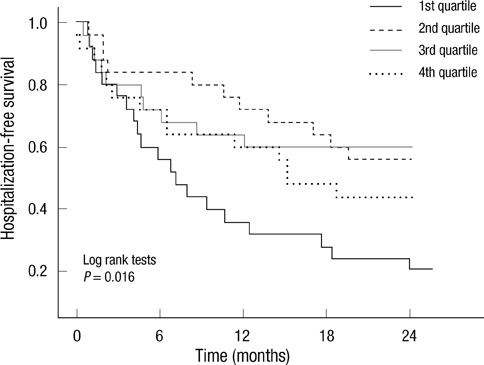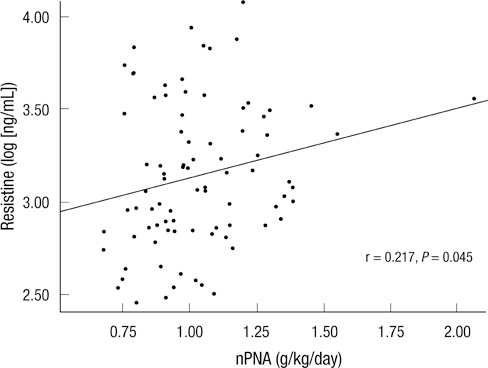J Korean Med Sci.
2012 Apr;27(4):377-381. 10.3346/jkms.2012.27.4.377.
Low Resistin Level is Associated with Poor Hospitalization-Free Survival in Hemodialysis Patients
- Affiliations
-
- 1Department of Internal Medicine, Gachon University of Medicine and Science, Incheon, Korea. sejoong2@snu.ac.kr
- 2Department of Internal Medicine, Seoul National University Hospital, Seoul, Korea.
- 3Department of Internal Medicine, Seoul National University Bundang Hospital, Seongnam, Korea.
- KMID: 2157897
- DOI: http://doi.org/10.3346/jkms.2012.27.4.377
Abstract
- Malnutrition and inflammation are related to high rates of morbidity and mortality in hemodialysis patients. Resistin is associated with nutrition and inflammation. We attempted to determine whether resistin levels may predict clinical outcomes in hemodialysis patients. We conducted a prospective evaluation of 100 outpatients on hemodialysis in a single dialysis center (male, 46%; mean age, 53.7 +/- 16.4 yr). We stratified the patients into 4 groups according to quartiles of serum resistin levels. During the 18-month observational period, patients with the lowest quartile of serum resistin levels had poor hospitalization-free survival (log rank test, P = 0.016). After adjustment of all co-variables, patients with the lowest quartile of serum resistin levels had poor hospitalization-free survival, compared with reference resistin levels. Higher levels of interleukin-6 were an independent predictor of poor hospitalization-free survival. In contrast, serum resistin levels were not correlated with interleukin-6 levels. The current data showed that low resistin levels may independently predict poor hospitalization free survival in hemodialysis patients.
Keyword
MeSH Terms
Figure
Reference
-
1. Jin DC. Current status of dialysis therapy in Korea. Korean J Intern Med. 2011. 26:123–131.2. Carrero JJ, Stenvinkel P. Inflammation in end-stage renal disease: what have we learned in 10 years? Semin Dial. 2010. 23:498–509.3. Kalantar-Zadeh K, Ikizler TA, Block G, Avram MM, Kopple JD. Malnutrition-inflammation complex syndrome in dialysis patients: causes and consequences. Am J Kidney Dis. 2003. 42:864–881.4. Bologa RM, Levine DM, Parker TS, Cheigh JS, Serur D, Stenzel KH, Rubin AL. Interleukin-6 predicts hypoalbuminemia, hypocholesterolemia, and mortality in hemodialysis patients. Am J Kidney Dis. 1998. 32:107–114.5. Merabet E, Dagogo-Jack S, Coyne DW, Klein S, Santiago JV, Hmiel SP, Landt M. Increased plasma leptin concentration in end-stage renal disease. J Clin Endocrinol Metab. 1997. 82:847–850.6. Zoccali C, Mallamaci F, Tripepi G, Benedetto FA, Cutrupi S, Parlongo S, Malatino LS, Bonanno G, Seminara G, Rapisarda F, Fatuzzo P, Buemi M, Nicocia G, Tanaka S, Ouchi N, Kihara S, Funahashi T, Matsuzawa Y. Adiponectin, metabolic risk factors, and cardiovascular events among patients with end-stage renal disease. J Am Soc Nephrol. 2002. 13:134–141.7. Guzik TJ, Mangalat D, Korbut R. Adipocytokines: novel link between inflammation and vascular function? J Physiol Pharmacol. 2006. 57:505–528.8. Malyszko J, Malyszko JS, Kozminski P, Pawlak K, Mysliwiec M. Elevated resistin is related to inflammation and residual renal function in haemodialysed patients. Nephrology (Carlton). 2007. 12:246–253.9. Daugirdas JT. Simplified equations for monitoring Kt/V, PCRn, eKt/V, and ePCRn. Adv Ren Replace Ther. 1995. 2:295–304.10. Depner TA, Daugirdas JT. Equations for normalized protein catabolic rate based on two-point modeling of hemodialysis urea kinetics. J Am Soc Nephrol. 1996. 7:780–785.11. Nüsken KD, Kratzsch J, Wienholz V, Stohr W, Rascher W, Dötsch J. Circulating resistin concentrations in children depend on renal function. Nephrol Dial Transplant. 2006. 21:107–112.12. Axelsson J, Bergsten A, Qureshi AR, Heimburger O, Bárány P, Lönnqvist F, Lindholm B, Nordfors L, Alvestrand A, Stenvinkel P. Elevated resistin levels in chronic kidney disease are associated with decreased glomerular filtration rate and inflammation, but not with insulin resistance. Kidney Int. 2006. 69:596–604.13. Liakopoulos V, Mertens PR, Eleftheriadis T, Koukoulis G, Stefanidis I. Is there a link between inflammation, plasma resistin levels, and protein malnutrition in hemodialysis patients? Kidney Int. 2006. 70:1371–1372.14. Fagerberg B, Fagerlund C, Hulthe J. Resistin and GFR. Kidney Int. 2006. 70:1371.15. Kielstein JT, Becker B, Graf S, Brabant G, Haller H, Fliser D. Increased resistin blood levels are not associated with insulin resistance in patients with renal disease. Am J Kidney Dis. 2003. 42:62–66.16. Mak RH, Cheung W. Adipokines and gut hormones in end-stage renal disease. Perit Dial Int. 2007. 27:S298–S302.17. Małgorzewicz S, Aleksandrowicz-Wrona E, Owczarzak A, Debska-Slizień A, Rutkowski B, Łysiak-Szydłowska W. Adipokines and nutritional status for patients on maintenance hemodialysis. J Ren Nutr. 2010. 20:303–308.18. Wang QY, Zhang H, Yan X, Kang J, Yu RJ. Serum resistin and leptin in patients with chronic obstructive pulmonary disease and their relationship to nutritional state. Zhonghua Jie He He Hu Xi Za Zhi. 2005. 28:445–447.19. Dostalova I, Kunesova M, Duskova J, Papezova H, Nedvidkova J. Adipose tissue resistin levels in patients with anorexia nervosa. Nutrition. 2006. 22:977–983.20. Kalantar-Zadeh K, Block G, Humphreys MH, Kopple JD. Reverse epidemiology of cardiovascular risk factors in maintenance dialysis patients. Kidney Int. 2003. 63:793–808.21. Filippidis G, Liakopoulos V, Mertens PR, Kiropoulos T, Stakias N, Verikouki C, Patsidis E, Koukoulis G, Stefanidis I. Resistin serum levels are increased but not correlated with insulin resistance in chronic hemodialysis patients. Blood Purif. 2005. 23:421–428.22. Yannakoulia M, Yiannakouris N, Blüher S, Matalas AL, Klimis-Zacas D, Mantzoros CS. Body fat mass and macronutrient intake in relation to circulating soluble leptin receptor, free leptin index, adiponectin, and resistin concentrations in healthy humans. J Clin Endocrinol Metab. 2003. 88:1730–1736.23. Barreto DV, Barreto FC, Liabeuf S, Temmar M, Lemke HD, Tribouilloy C, Choukroun G, Vanholder R, Massy ZA. European Uremic Toxic Work Group (EUTox). Plasma interleukin-6 is independently associated with mortality in both hemodialysis and pre-dialysis patients with chronic kidney disease. Kidney Int. 2010. 77:550–556.24. Cohen G, Hörl WH. Resistin as a cardiovascular and atherosclerotic risk factor and uremic toxin. Semin Dial. 2009. 22:373–377.25. Chang JH, Jung JY, Lee HH, Chung W, Joo KW, Kim S. Serum resistin as a novel marker of erythropoietin resistance in nondiabetic patients on hemodialysis. Tohoku J Exp Med. 2011. 224:281–285.26. Díez JJ, Iglesias P, Fernández-Reyes MJ, Aguilera A, Bajo MA, Alvarez-Fidalgo P, Codoceo R, Selgas R. Serum concentrations of leptin, adiponectin and resistin, and their relationship with cardiovascular disease in patients with end-stage renal disease. Clin Endocrinol (Oxf). 2005. 62:242–249.27. Taskapan MC, Taskapan H, Sahin I, Keskin L, Atmaca H, Ozyalin F. Serum leptin, resistin, and lipid levels in patients with end stage renal failure with regard to dialysis modality. Ren Fail. 2007. 29:147–154.28. Bommer J, Locatelli F, Satayathum S, Keen ML, Goodkin DA, Saito A, Akiba T, Port FK, Young EW. Association of predialysis serum bicarbonate levels with risk of mortality and hospitalization in the Dialysis Outcomes and Practice Patterns Study (DOPPS). Am J Kidney Dis. 2004. 44:661–671.29. Yano A, Nakao K, Sarai A, Akagi S, Kihara T, Morimoto H, Nakamura A, Hiramatsu M, Nagake Y, Makino H. Elevated serum interleukin-18 levels might reflect the high risk of hospitalization in patients on peritoneal dialysis. Nephrology (Carlton). 2005. 10:576–582.



